Winter brings its own set of challenges when it comes to grooming your beloved German Shepherd. As the temperatures drop and the air turns cold and dry, grooming becomes a vital aspect.
Now, as a proud owner of a majestic German Shepherd, you’ve likely wondered, can I groom my German Shepherd in the winter? It’s a question that crosses your mind during the colder months.
Absolutely, you can groom your German Shepherd in the winter. Grooming your German Shepherd in winter helps maintain a healthy coat, reducing matting and aiding in temperature regulation. Additionally, it also helps in preventing the accumulation of ice and snow between his paw pads.
This article is designed to answer your most pressing questions about grooming German Shepherds during the winter season.
From preventing matting and dry skin to choosing the right products and avoiding common mistakes, you’ll discover the secrets to keeping your loyal companion looking and feeling his best in the chilliest of months.
Let’s embark on the winter grooming journey!
Contents
- 1 Is It OK To Groom Your German Shepherd In The Winter?
- 2 Challenges In Grooming Your German Shepherd In The Winter
- 3 7 Essential Tips To Groom Your German Shepherd In The Winter
- 4 Common Winter Grooming Mistakes To Avoid For Your German Shepherd
- 5 Conclusion:
- 6 Frequently Asked Questions:
- 6.1 Can I shave my German Shepherd in the Winter?
- 6.2 Do German Shepherds get a winter coat?
- 6.3 Should I adjust my dog’s diet for winter grooming?
- 6.4 How can I protect my German Shepherd’s coat from the harsh winter elements?
- 6.5 How cold is too cold for a German Shepherd?
- 6.6 What is a winter cut for German Shepherds?
- 6.7 Resources Used for Research:
Is It OK To Groom Your German Shepherd In The Winter?
Grooming your German Shepherd during the winter is not only okay but also highly recommended.
While it might seem counterintuitive to groom a dog with a thick, insulating coat in the colder months, winter grooming is essential for your dog’s health and comfort.
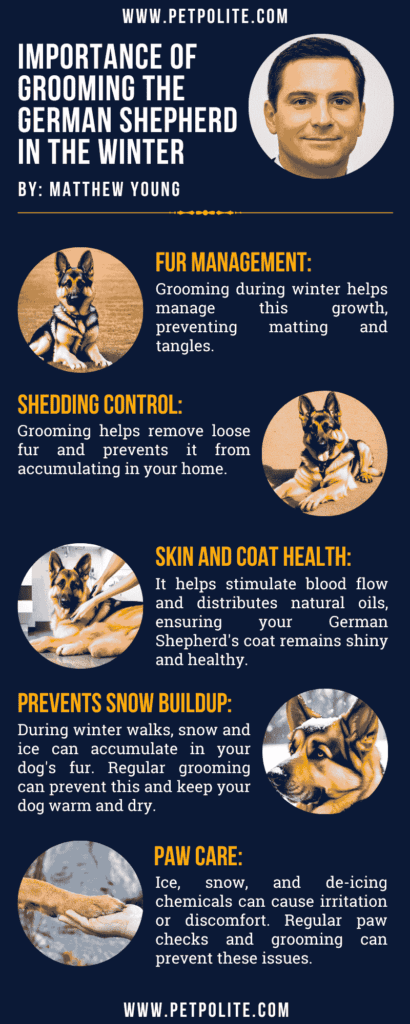
Here’s why you should continue grooming your German Shepherd during the winter:
1. Fur Management:
Winter doesn’t mean your German Shepherd’s fur doesn’t grow.
In fact, his coat may become even denser in preparation for the cold weather.
Grooming during winter helps manage this growth, preventing matting and tangles.
Matting can trap moisture close to the skin, leading to skin issues or discomfort.
2. Shedding Control:
German Shepherds are known for shedding, and winter is no exception.
Grooming helps remove loose fur and prevents it from accumulating in your home.
It’s especially crucial during winters when you and your dog spend more time indoors.
3. Skin and Coat Health:
Grooming improves coat health and reduces the chances of skin issues in your German Shepherd during the winter season.
It helps stimulate blood flow and distributes natural oils to keep your German Shepherd’s coat shiny.
The dry winter air can make your dog’s skin itchy, so regular grooming provides relief.

Winter grooming is especially important to help keep your dog’s skin and coat healthy during the cold weather months.”
Source – American Kennel Club (AKC)
4. Preventing Snow and Ice Buildup:
During winter walks, snow and ice can accumulate in your dog’s fur.
This can be uncomfortable for your German Shepherd and may lead to frostbite.
Regular grooming can help prevent snow and ice buildup and keep your dog warm and dry.
5. Paw Care:
Don’t forget to pay attention to your German Shepherd’s paws during winter grooming.
Ice, snow, and de-icing chemicals can cause irritation or discomfort.
Regular paw checks and grooming can prevent these issues.
Challenges In Grooming Your German Shepherd In The Winter
Grooming your German Shepherd in the winter can be quite an adventure, and there are some unique challenges you might face.
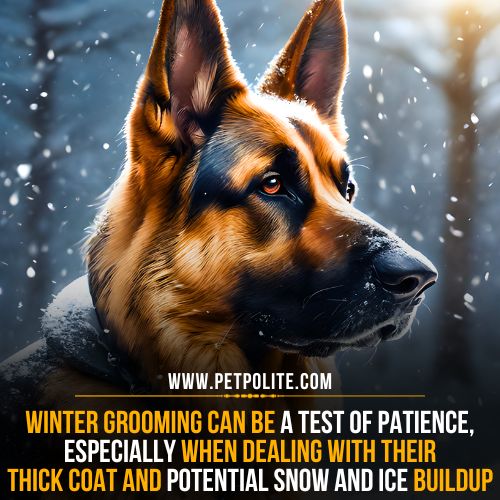

1. Matted and Tangled Fur:
As you groom your German Shepherd during the winter months, you may notice that their fur is more prone to matting and tangling.
Snow and ice can get stuck in their coat, causing knots and tangles that can be painful for your dog.
If left untreated, matting and tangling can lead to more serious health issues.
2. Dry Skin and Coat:
Winter weather can also cause dry skin and coat for your German Shepherd.
The cold weather and lack of moisture can strip the natural oils from their skin and coat, leading to dryness and irritation.
This can lead to scratching, chewing, and licking, which can further irritate the skin.
3. Snow and Ice:
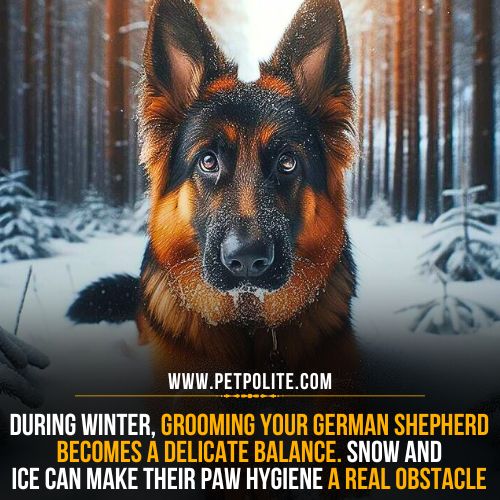

Snow and ice can accumulate on your dog’s paws and fur, making grooming a challenge.
Removing snow and ice from your dog’s paws and fur can be difficult and time-consuming, and if not done properly, can lead to more serious health issues.
4. Shorter Days:
The summer grooming routine of your German Shepherd allows ample time for thorough care, but during winter, shorter days can make it challenging.
There is less natural light, making it more difficult to see what you’re doing, and grooming in low light can lead to mistakes and accidents.
5. Cold Temperatures:
Grooming your German Shepherd in cold temperatures can be a challenge for both you and your GSD.
The cold weather can make your dog uncomfortable and irritable, and grooming in cold temperatures can cause their muscles to tense up.
7 Essential Tips To Groom Your German Shepherd In The Winter
With that thick double coat of your German Shepherd and the biting cold outside, keeping your furry friend comfortable is a priority.
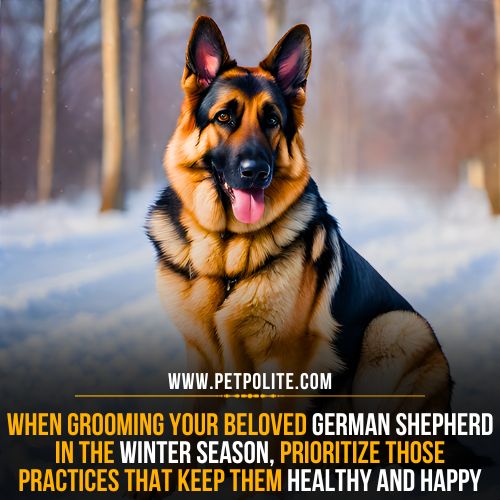

Keep these 7 essential tips in mind while planning to groom your German Shepherd in the winter:
1. Brushing:
Your German Shepherd’s undercoat helps to keep him warm in the winter, but it can also become matted and tangled if not brushed regularly.
In the winter, it is especially important to brush your German Shepherd daily or at least 3-4 times a week to remove loose hair, prevent matting, and distribute natural oils.
German Shepherds tend to shed a bit more in the winter, so a slicker brush or an undercoat rake is your best friend.
Here are some tips for brushing your German Shepherd in the winter:
- Start by brushing the head and neck, and then work your way down the body.
- Be sure to brush the legs and tail, as these areas are prone to matting.
- Brush in the direction of hair growth.
- If you encounter any mats, gently tease them apart with your fingers or a wide-tooth comb.
2. Bathing:
Nobody likes a chilly bath, right? Your Shepherd included.




“Bathing your German Shepherd in the winter is a bit of a challenge, but it’s important to keep him clean and odor-free. Just be sure to use a warm bath and dry him off thoroughly.”
Source – Dogster.com
In the winter, try to limit baths as much as possible. Bathing after every 6-8 weeks is enough for your German Shepherd.
Frequent washing can strip away those natural oils that keep his skin and coat healthy.
But if he is truly in need of a wash, use a moisturizing, dog-specific shampoo, and make sure he is completely dry before going out into the cold.
Here’s a video guide on how to bathe your German Shepherd in the winter like a professional:
3. Nail Trimming:
Trimming your German Shepherd’s nails is an important part of grooming, and it’s especially important to do in the winter.
This is because long nails can be uncomfortable and painful for your dog, and they can also lead to health problems such as ingrown nails and arthritis.
You should trim your German Shepherd’s nails every 2-3 weeks, or more often if needed. The faster your dog’s nails grow, the more often you’ll need to trim them.
Keep those nails at a comfortable length so your furry friend can trot around happily.
It’s like a little home pedicure session!
4. Paw Care:
This is one of the most critical aspects of your German Shepherd’s winter care as winter walks come with salt and chemicals on the sidewalks.
That’s harsh on your dog’s paws. To protect your German Shepherd’s paws from these harsh conditions, consider providing him with some stylish dog booties.
After a stroll, don’t forget to rinse and dry your German Shepherd’s paws – it’s like giving him a warm foot bath.




“Trimming your German Shepherd’s paws in the winter helps to prevent snow and ice from building up between his toes. It also helps to keep his nails short and prevent them from cracking or splitting.”
Source – The Spruce Pets
5. Eye Cleaning:
German Shepherds are prone to eye discharge, especially in the winter. This is because the cold weather can dry out their eyes and make them more susceptible to irritants.
It is important to clean your German Shepherd’s eyes daily or at least 3-4 times a week in the winter season to prevent infections and keep them comfortable.
Gently wipe away any discharge from the corners of the eyes using a cotton ball or gauze pad soaked in a vet-recommended eye wash.
If there is any discharge in the tear ducts, you can gently flush them with eye wash.
6. Ear Cleaning:
To protect against ear infection in your German Shepherd during the winter season, clean his ears 1-2 times a week, or more often if needed.
If your dog has a lot of earwax or discharge, you may need to clean his ears more often.
To clean your German Shepherd’s ears, gently pull back the ear flap and expose the ear canal.
Apply a small amount of ear cleaner to a cotton ball or gauze pad.
Gently wipe the inside of the ear canal, being careful not to go too deep.
7. Teeth Cleaning:
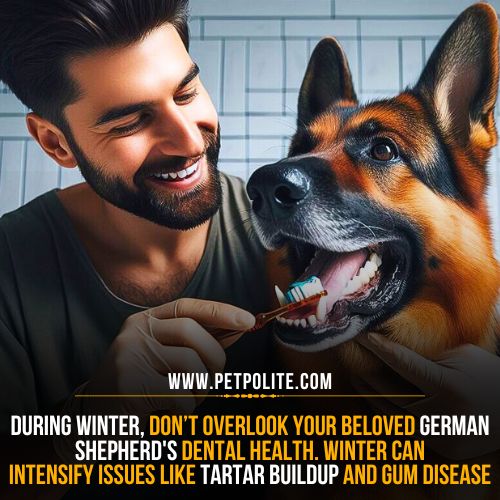

During the winter, your German Shepherd’s teeth can become more prone to tartar buildup, plaque, and gum disease.
This is because they might be eating more dry food, which can lead to dry mouth and reduced saliva production.
Saliva helps neutralize acids and remineralize teeth, so when it’s lacking, teeth can become more susceptible to decay and other issues.
During winter, brush your German Shepherd’s teeth daily, if possible, or at least 2-3 times a week.
Use a toothbrush specifically designed for dogs, as they have softer bristles and a smaller head.
Make teeth cleaning a positive experience with treats and praise!
Here’s a suggested grooming schedule for your German Shepherd in the winter:
| Task | Frequency | Description |
|---|---|---|
| Brushing | 3-4 times a week | Remove loose hair, and stimulate natural oils. |
| Bathing | Every 6-8 weeks | Use dog shampoo for thorough cleaning. |
| Paw Care | As needed | Check and clean your dog’s paws regularly. After walks, remove ice, snow, and salt. |
| Ear Cleaning | 1-2 times a week | Use dog ear cleaner to prevent infections. |
| Nail Trimming | Every 2-3 weeks | Prevent overgrowth and discomfort. |
| Eye Cleaning | 3-4 times a week | Thin your dog’s coat with an undercoat rake. |
| Teeth Cleaning | 2-3 times a week | Brush your GSD’s teeth with dog-specific toothbrush |
Common Winter Grooming Mistakes To Avoid For Your German Shepherd
While grooming your German Shepherd in the winter season is crucial, there are common mistakes that you should steer clear of to ensure the best care for your furry friend.


Let’s take a look at what to avoid:
- Over-Bathing: Excessive bathing can strip away the natural oils in his coat and lead to dryness and skin irritation. Instead, opt for a bath every 2-3 months or as needed, and use dog-friendly shampoos.
- Skipping Regular Brushing: With his thickening winter coat, skipping regular brushing sessions is a big no-no. Neglecting brushing can result in matting and tangling, making your dog uncomfortable.
- Inadequate Drying: After a bath or a winter walk, failing to dry your German Shepherd thoroughly can cause discomfort and even health issues.
- Using Human Shampoo: Using human shampoo on your dog is a common mistake. Human shampoos are not formulated for a dog’s pH levels, and they can lead to skin issues.
- Neglecting Paw Care: Your dog’s paws need attention during winter. The cold ground, snow, and ice can cause discomfort or damage.
- Rushing Through Grooming: Grooming in the winter requires a little extra time and care. Rushing through the process can lead to overlooked mats, or missed opportunities to check your dog’s skin issues.
Conclusion:
In conclusion, grooming your German Shepherd in the winter is a vital part of ensuring his health and well-being.
While the colder months present unique challenges, avoiding common grooming mistakes is essential.
By steering clear of over-bathing, maintaining a regular brushing routine, taking care of your dog’s paws, and paying attention to his diet and hydration, you can keep him comfortable during the winter.
Seek advice from experts when in doubt to provide the best care possible.
Winter grooming is a testament to the bond you share with your loyal companion, offering him warmth, comfort, and a radiant appearance even in the chilliest of seasons.
Frequently Asked Questions:
Can I shave my German Shepherd in the Winter?
Shaving your German Shepherd’s coat in winter is not recommended. His double coat provides insulation, and shaving can disrupt his natural temperature regulation.
Do German Shepherds get a winter coat?
Yes, German Shepherds develop a thicker winter coat in colder months to provide insulation and protect them from low temperatures.
Should I adjust my dog’s diet for winter grooming?
Yes, you can consider adjusting your dog’s diet by including foods rich in omega-3 fatty acids, which promote coat health. Ensure he has access to clean water at all times to prevent dehydration, which can lead to dry skin.
How can I protect my German Shepherd’s coat from the harsh winter elements?
To protect your dog’s coat in winter, maintain a regular grooming routine, use dog-friendly products, and take precautions when your dog is outdoors. Protective balms or booties can safeguard his paws from cold surfaces and chemicals, and brushing can help prevent matting from snow and ice.
How cold is too cold for a German Shepherd?
A German Shepherd can tolerate cold temperatures quite well, typically down to 20°F (-6°C). However, it’s essential to consider factors like wind chill, duration of exposure, and the dog’s age and health.
What is a winter cut for German Shepherds?
A winter cut involves leaving your GSD’s coat at its natural length to provide insulation against the cold weather. This means avoiding trimming or shaving their fur short. Regular grooming to remove loose hair and prevent matting is still necessary.
Resources Used for Research:
- The development of social structure during the primary socialization period in German shepherds – Wiley Online Library
- Genetic dissection of complex behaviour traits in German Shepherd dogs
- German Shepherds: A Practical Guide for Owners and Breeders – A Book by Allison Clarke and Lizzy Brown
- Dog Groomer’s Manual: A Definitive Guide to the Science, Practice and Art of Dog Grooming: A Book by Sue Gould